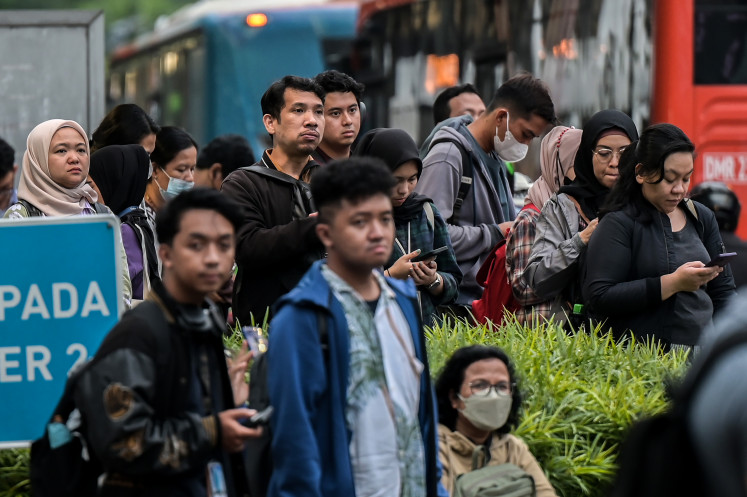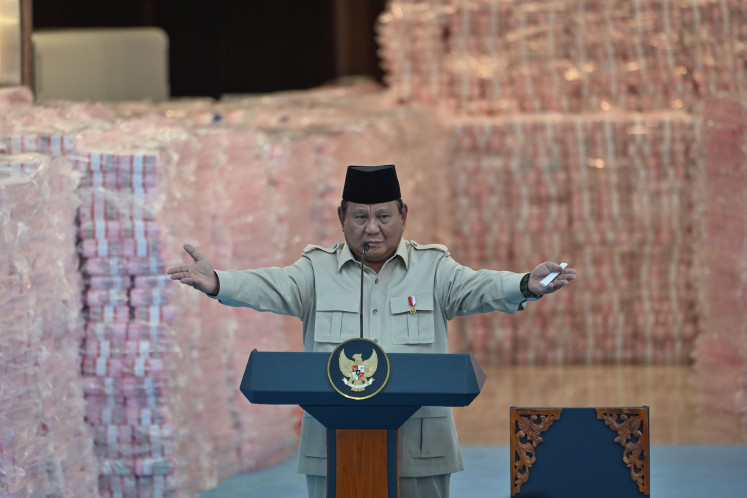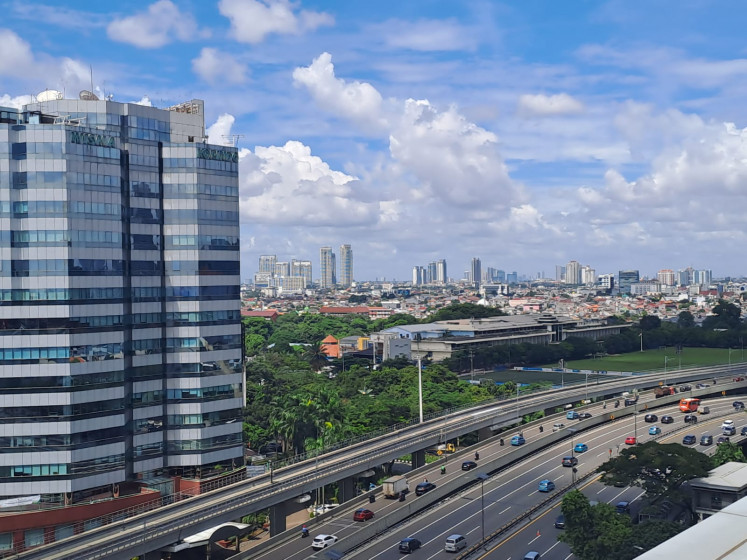Popular Reads
Top Results
Can't find what you're looking for?
View all search resultsPopular Reads
Top Results
Can't find what you're looking for?
View all search resultsEncouraging the receipt of Indonesian remittances
In the 2021 national balance of payments, the current account deficit was recorded at US$2.2 billion, double the previous quarter's deficit.
Change text size
Gift Premium Articles
to Anyone
A
s the COVID-19 pandemic has spread globally since early 2020, the placement of Indonesian migrant workers (TKI) to destination countries has also decreased. TKI placements in 2020 dropped by 59 percent year-on-year. The figure is also only about a fifth of TKI placements 10 years ago. The pandemic and economic slowdown in major destination countries contributed to the decline. In particular, the pandemic limits international mobility and the global economic crisis lowers the demand for migrant workers. This further affects the remittances sent to the country.
The remittances, indeed, have a large economic and social impact, ranging from supporting the current account and helping the local economy of migrant worker families to their role in accelerating national financial inclusion. In the 2021 national balance of payments, the current account deficit was recorded at US$2.2 billion, double the previous quarter's deficit. There are several factors that contributed to this, such as an increase in the services and primary income account deficit. However, on the other hand, goods and secondary income experienced a surplus. In the secondary income balance, the receipts reached $2.6 billion, of which 87 percent was contributed by personal transfers made by TKIs through remittances sent to the country.
If we are able to maximize the remittance receipts, then the performance of the current account will be better as well. In 2020, Indonesia's inflow remittances amounted to $9.4 billion. The figure is only about 55 percent of that received by Vietnam ($17.2 billion) and 27 percent of that in the Philippines ($34.9 billion). If we can increase remittance receipts to be equivalent to Vietnam, our 2020 current account balance will increase from a $4.4 billion deficit to a $3.3 billion surplus. And if it reaches the Philippines' level, the current account surplus will increase to $21 billion. Indeed, this is a big potential, as well as a challenge, that must be resolved through collaboration actions. More importantly, those two countries —the Philippines and Vietnam — could provide lessons for us to improve income from remittances.
If we reflect on the current trend of remittances, the remittances sent by TKIs tends to decline. Until the first half of 2021, the amount sent reached $4.53 billion, lower than the same period in 2019 ($4.86 billion) and also slightly lower than in the second half of 2020 ($4.56 billion).
According to Bank Indonesia (BI), the main remittance contributors only come from two regions, namely the Asia Pacific and the Middle East. In the first quarter of this year, the Asia Pacific's contribution reached 63 percent, with the main senders being Malaysia, Taiwan and Hong Kong, while those from the Middle East reached 36 percent, especially from Saudi Arabia, the United Arab Emirates and Jordan.
Currently, half of our TKIs work in Malaysia, a quarter in Saudi Arabia, while 16 percent work in Taiwan and Hong Kong. A relatively small portion is working in the United States, Australia and Europe. However, when it comes to the remittance per worker from those major destination countries, such as Malaysia and Asian countries, the figure is relatively low compared to the remittance per worker coming from the US, Australia and Europe. For example, in 2020, the remittance per migrant worker from the US was 31 times greater than in the Middle East and 64 times greater than ASEAN.
This may not be surprising as migrant workers in developed countries would fare better. But it highlights several important facts: Countries with larger remittances per worker are not main destinations and investing and diversifying skills for migrant workers are a key point. Interestingly, there is an upward trend from Africa, where the value in 2020 is about 4.4 times greater than 2019 and was the second-highest after the US.
Given the unfavorable situation, how could we tap the remittance potential? There are several strategies that deserve further attention. The first is related to the size of Indonesian remittances and the channel of sending money. It is also important to understand TKI behaviors in sending money to the country. Anecdotal evidence suggests that many TKI use informal channels. For example, they send the money through their colleagues who will return to Indonesia. As a result, the amount of money remitted is not recorded in the formal recording system, suggesting underestimated remittance data.
Perhaps the cost-related considerations — banks or money transfer operators — are viewed quite expensive and are a major barrier for migrant workers to use formal channels.
According to the International Organization for Migration (IOM), the average cost of remittances of $200 to Indonesia in 2020 reached 6.5 percent, relatively higher than some other developing countries. In comparison, the average cost of remittances to the Philippines in 2020 is 29 percent lower than Indonesia.
To address the cost of sending money, the Local Currency Settlement (LCS) scheme initiated by BI with several countries, such as Malaysia, Thailand and Japan, will lower the cost. This is a strategic initiative to encourage remittances to be carried out more often through formal channels while ensuring the funds received by the TKIs families are not much reduced so they can help the local economy more optimally.
Improving the skills of TKIs to fill high-quality jobs should be another strategy. Unfortunately, the limited number of skilled workers with professional licenses and certificates is an obstacle. For example, every year, Indonesia produces 50,000 nurses, but only 20,0000 to 30,000 nurses are absorbed domestically. On the other hand, there is a huge opportunity regarding the high demand for nurses' services; for example, in the US, which requires around 1 million nurses up to 2030.
The Philippines and Vietnam are more proactive in capturing this opportunity. In the Philippines, when there is a changing nursing curriculum in the US, the country will also adjust its curriculum. Meanwhile, Vietnam is implementing a German nursing curriculum.
Reflecting on those two countries, we may need to train our migrant workers to be more adaptive to changes in destination countries. For example, training for migrant workers can be more up-to-date and flexible enough to follow the needs of the industry. This means that we need to increase the link-and-match program with the industry in the destination countries. Second, we need to start thinking about diversifying in sending migrant workers and push more high-skilled workers. Exploring and understanding the needs of the US nursing market could be a key strategy to enter the developed countries’ markets.
***
Analyst at Mandiri Institute










